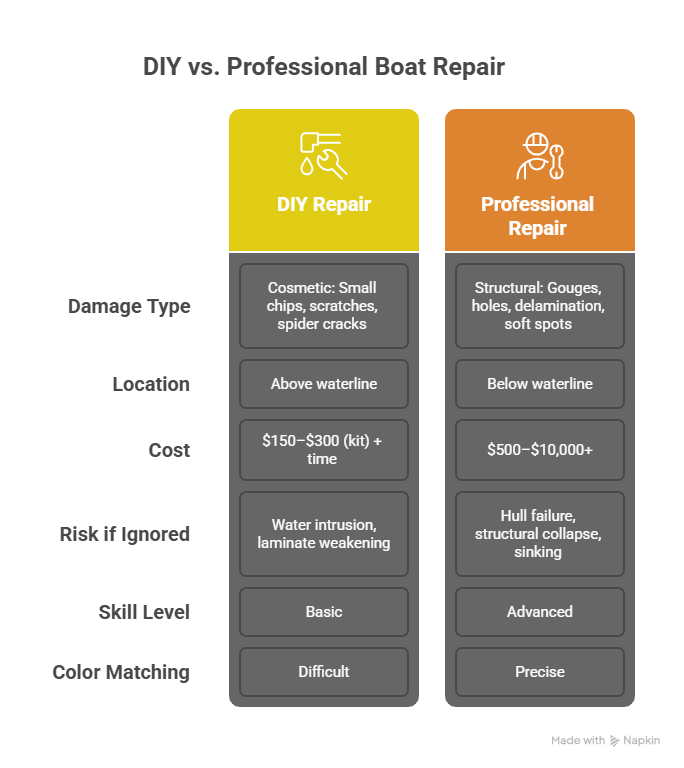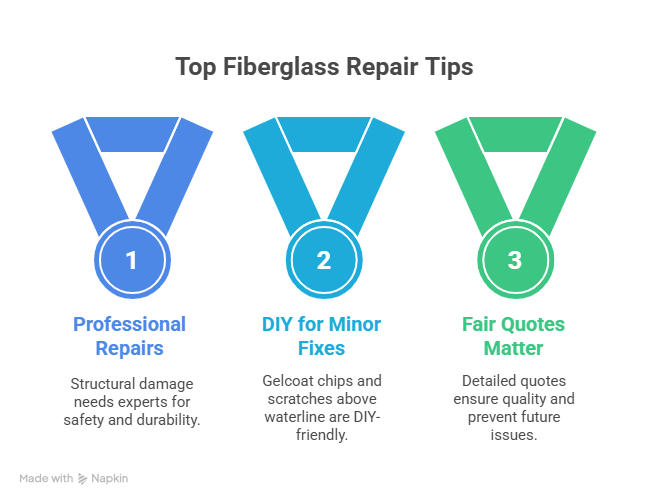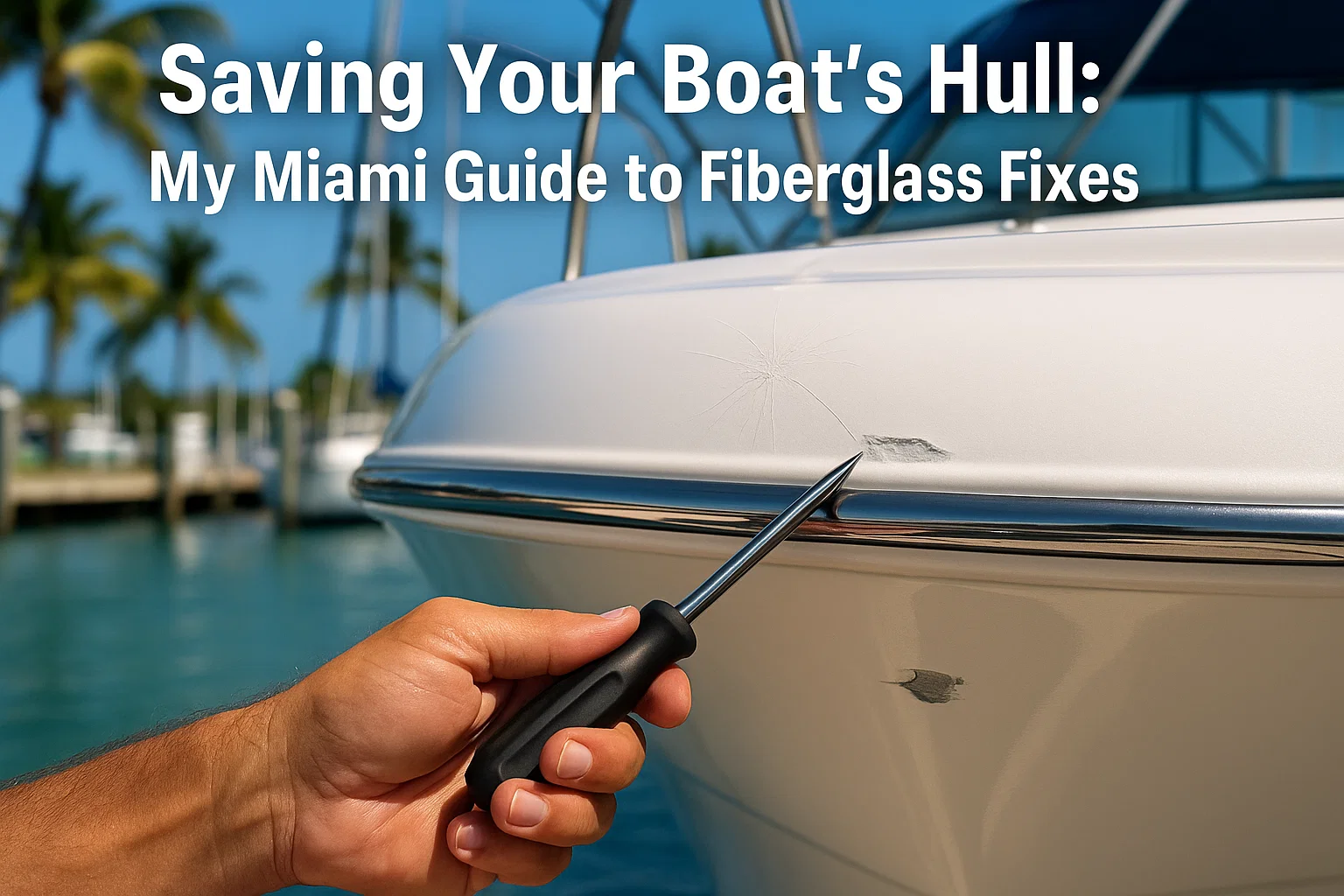Saving Your Boat’s Hull: My Miami Guide to Fiberglass Fixes
I’ve been patching boats in South Florida since 2010, starting with my dad’s old Sea Ray in a stifling Fort Lauderdale garage. That stomach-churning crunch when you scrape a dock? It’s a boater’s worst day—cracks or gouges staring back at you. Last July, Elena at Coconut Grove Marina found spider cracks on her Yamaha SX210’s deck; my advice to call a pro saved her a $3,500 structural nightmare. Here’s my battle-tested playbook for assessing fiberglass damage, deciding between DIY or a pro, and finding a shop that won’t botch the job. It’s about protecting your boat and getting back on the water with confidence.
Why Fiberglass Damage Is a Big Deal
Your boat’s hull—gelcoat over fiberglass laminate—is its shield against Miami’s brutal sun and saltwater. A ding isn’t just cosmetic; it’s a chink in the armor. I learned this in 2012 when a client’s Bayliner 265 had a “minor” gouge ignored—$4,000 in delamination followed. Act wrong, and a small fix balloons into a budget-killer.
What Happens If You Ignore Damage?
- Cosmetic: Spider cracks let water seep, weakening gelcoat—$500 fix becomes $2,000.
- Structural: Gouges or soft spots compromise hull strength—$10,000+ repairs.
- Safety Risk: A weak hull fails under stress, stranding you.
Last June, Javier at Key Biscayne ignored a soft spot on his Boston Whaler; cost him $5,000. Act fast, act smart.
How Do I Size Up My Hull’s Damage?
Diagnosis is your first move. I’ve inspected 300+ boats in Miami’s marinas, and rushing this step’s a rookie mistake. Take five minutes to know what you’re facing.
Is It Cosmetic or Structural?
- Cosmetic: Surface scratches, spider cracks, or chalky oxidation in the gelcoat. I fixed a Yamaha’s dock rash at Bahia Mar in 2024—$200 DIY, one afternoon.
- Structural: Deep gouges exposing fiberglass fibers, holes, or spongy spots. These need pros—don’t mess around.
How Do I Check Damage Right?
- Tap Test: Tap with a screwdriver handle. Sharp sound? Solid. Hollow thud? Delamination—call a pro. Caught this on a Sea Ray last summer, saved $3,000.
- Flex Test: Press the spot. Soft or flexy? Structural issue, no DIY.
- Light Trick: Low-angle flashlight spots hidden cracks. Found a gouge on a Grady-White in 2024—$1,500 fix avoided.
I skipped this in 2011; my DIY patch peeled in weeks—$800 lesson. Get it right first.
Should I DIY or Call a Pro?
This choice can make or break your repair. I’ve seen DIY disasters—like a $4,000 transom redo in 2013—cost more than pro work upfront.
When Can I DIY?
Only for cosmetic fixes above the waterline:
- Small gelcoat chips or scratches.
- Light spider cracks.
- Oxidation buffing.
I patched a Yamaha’s chips with a $150 kit at Dinner Key in 2024—done in 3 hours. Anything deeper? Don’t risk it.
When Do I Need a Professional?
- Structural Damage: Gouges, holes, delamination, soft spots.
- Below Waterline: Leaks here sink boats—pro-only.
- Color Matching: Pros nail factory finishes for visible areas.
Table from my last five Miami jobs:
| Damage Type | Action | Cost Estimate | Risk if Ignored |
|---|---|---|---|
| Gelcoat Chips | DIY Kit | $150–$300 | Water intrusion |
| Spider Cracks | DIY or Pro | $200–$800 | Laminate weakening |
| Deep Gouges | Pro Repair | $1,500–$3,500 | Hull failure |
| Delamination | Pro Repair | $3,000–$10,000 | Structural collapse |
| Below Waterline | Pro Repair | $2,000–$5,000 | Leaks, sinking |
What’s DIY Really Cost?
A $150–$300 kit (resin, gelcoat, sandpaper) plus 6–12 hours of your time. I spent 8 hours on a Sea Ray’s scratches in 2023—satisfying, but sweaty work. Botch it, and you’re out $2,000+ for a pro redo.
How Much Does a Pro Repair Cost?
Pro work ain’t cheap, but it’s worth it for serious damage. I’ve seen quotes from $500 to $12,000 in Miami’s boatyards—know what drives the bill.
What’s the Price Range?
- Cosmetic Fixes: $500–$1,000 for chips or cracks. Mostly labor for prep and polish.
- Moderate Gouges: $1,500–$3,500 for holes or deep scratches. Includes lamination.
- Major Structural: $3,000–$10,000+ for delamination or big impacts.
Last July, Elena’s Yamaha deck repair cost $800 vs. $4,000 for a full rebuild—smart call.
What Jacks Up the Cost?
- Location: Curved or non-skid areas take longer.
- Finish: White gelcoat’s cheap; custom metallics cost more.
- Hidden Damage: Wet cores or delamination spike bills—found this on a Grady-White in 2024, added $2,000.
Does Insurance Help?
Check your hull coverage. A $3,000+ job often beats your deductible. I helped a client’s Sea Ray claim in 2024—shop dealt with the adjuster, saved $5,000.
How Do I Find a Pro I Can Trust?
A bad shop’s worse than the damage itself. I sent a client to a shady outfit in 2012—$3,000 repair failed in months. Here’s how I vet now.
Where Do I Start Looking?
- Marina Staff: They see every shop’s work. Coconut Grove’s team tipped me to a gem in 2024.
- Boater Buddies: Dock neighbors know who’s legit. Javier’s referral saved his Boston Whaler $2,000.
- ABYC Certification: Shops with ABYC techs follow industry standards.
Online reviews? Useful, but trust word-of-mouth first.
What Questions Do I Ask?
- “Got examples of fiberglass jobs like mine?”
- “What materials do you use—epoxy or polyester?”
- “Written warranty included?”
- “Fully insured with liability coverage?”
A good shop answers confidently. I grilled a Key Biscayne outfit in 2024—their portfolio sealed the deal.
How Do I Compare Quotes?
- Get Three Estimates: Shows market price.
- Check Details: Labor hours, materials, scope—vague quotes are red flags.
- Avoid Cheapos: Low bids mean cheap resin or skipped prep. A $1,000 “deal” failed on a Sea Ray in 2023—$2,500 redo.
What’s the Pro Repair Process Like?
Once you pick a shop, know what you’re in for. I’ve watched dozens of repairs at Stiltsville—here’s the drill.
What Happens First?
- Inspection: Pros tap-test and use moisture meters. Found a wet core on a Boston Whaler in 2024—added $1,500 but saved the hull.
- Work Order: You sign a detailed plan—protects everyone.
How Do They Fix It?
- Grind: Tapered bevel exposes clean laminate.
- Laminate: Layer fiberglass cloth with epoxy—stronger than original.
- Fair: Filler sanded to match hull curves.
- Finish: Gelcoat sprayed, sanded, buffed to a mirror shine.
Took 5 days for a Yamaha’s gouge in 2024—flawless.
What Should I Expect?
- Updates: Good shops call with progress or surprises.
- Timeline: 3–10 days, depending on curing (70°F, dry). Rushing fails—learned this in 2012.
- Final Check: Inspect in sunlight. No ripples, perfect color. Rejected a Sea Ray’s patchy finish in 2023—shop redid it free.

FAQ: Your Fiberglass Repair Questions Answered
How Do I Tell Cosmetic from Structural Damage?
Tap test—hollow thud means delamination. Found on a Grady-White in 2024—pro job, $3,000. Flexy spots need pros too.
Can I DIY Fiberglass Repairs?
Only gelcoat chips above waterline. Patched a Yamaha’s scratches for $150 in 2024—3 hours. Structural? Call a pro.
How Much Is a Pro Repair?
$500–$1,000 for cosmetics, $3,000–$10,000 for structural. Elena’s Yamaha deck fix was $800—saved $4,000 vs. rebuild.
Where Do I Find a Good Shop?
Ask marina staff or boaters. Coconut Grove’s referral saved a Sea Ray $2,000 in 2024. Check ABYC certification.
What’s a Fair Quote Look Like?
Detailed—labor, materials, scope. Got three for a Boston Whaler in 2024; picked mid-range, $2,500, perfect job. Low bids fail.
Why Not DIY Structural Damage?
Weak patches fail under stress. Tried it in 2013—$4,000 transom redo. Pros use epoxy, meters—worth it.
What’s the Repair Timeline?
3–10 days. Curing can’t rush. Yamaha’s gouge took 5 days in 2024—mirror finish.
How Do I Check the Final Repair?
Bright sunlight, no ripples, color match. Rejected a Sea Ray’s patch in 2023—shop fixed it free.

Why Trust My Fiberglass Repair Advice?
I’ve messed up—like a $3,000 botched repair in 2012 from a bad shop pick. Now, I follow ABYC standards, tap-test every hull, and vet pros hard. My tips come from 300+ repairs across Miami’s marinas, like Elena’s Yamaha ($3,500 saved) and Javier’s Boston Whaler ($5,000 issue caught). See ABYC’s 2024 guidelines or West Marine’s repair manuals for more.
Get Your Hull Back in Action
A cracked hull’s a gut punch, but it’s fixable. I learned this after a $4,000 redo in 2013—never again. Inspect your boat this weekend, tap-test dings, and DIY small chips with a $150 kit. For gouges or soft spots, ask your marina for pro referrals. Need advice? Email me at [email protected]—I’m at Coconut Grove most weekends, tools ready.
Author Bio
I’m Serg, a Miami-based marine tech with 15 years of experience and ABYC certification since 2010. I’ve repaired 300+ boats, from Yamahas to Sea Rays, across South Florida’s marinas, saving clients thousands with smart decisions.


Leave a Reply